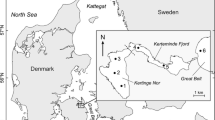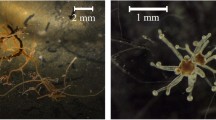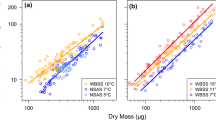Abstract
We speculated that Daphniopsis tibetana may be adapted to short-term lack of food through a mechanism of population growth compensation. D. tibetana were collected from Lake Namuka Co, Tibet, and acclimated to diluted seawater in 2007. All larvae used in experiments were synchronized newborn (<24-h old) and of an average body length of 790 (770–810) μm. We evaluated the effect of continuous starvation for 1, 3, 5, 7, 9, and 11 days and intermittent periods of starvation of 0.5, 1, 1.5, and 2 days on the compensatory population growth effect in D. tibetana. The duration of starvation significantly influenced population growth, body length, and heart rate. After 1 and 3 days of continuous starvation and 0.5 days intermittent starvation, the age of first reproduction was 16.3 days and the reproduction frequency was 0.8 (10 days−1), which were similar to the control group. In these two starved groups, lifetime fecundity values were 426.3 and 412.3, average life spans were 54.5 and 54.3 days, and intrinsic rates of increase (r m) were 0.136 and 0.133 days−1, respectively, which is significantly higher than the other starved groups and not different from the control group (P > 0.05). In the group with 7, 9, and 11 days of continuously starved groups, body lengths were significantly lower (P < 0.05) than those of controls. With increasing starvation time (1, 3, 5, and 7 days), heart rate progressively decreased (184, 178, 172, and 166 min−1). Body length, measured at the end of the experiment, declined with increasing duration of intermittent starvation. After 2 days of intermittent starvation, final heart rate sharply decreased to 150 min−1, which was highly significantly different from the other treatment groups. The results of this study conclude that D. tibetana is capable of complete compensatory population growth after short-term starvation.


Similar content being viewed by others
References
Anger K (1995) Starvation resistance in larvae of a semiterrestrial crab, Sesarma curacaoense (Decapoda: Grapsodae). J Exp Mar Biol Ecol 187:161–174
Auster PJ, Stewart LL (1984) Compensatory growth in the bay scallop, Argopecten irradians (L.). J Northw Alt Fish Sci 5:103–104
Berthoud HR (2011) Metabolic and hedonic drives in the neural control of appetite: who is the boss? Curr Opin Neurobiol 21:888–896
Brett JR (1979) Environmental factors and growth. In: Hoar WS, Randall DJ, Brett JR (eds) Fish physiology, Bioenergetics and growth, vol 8. Academic, New York, pp 599–677
Bychek EA, Dobson GA, Harwood JL, Guschina IA (2005) Daphnia magna Can tolerate short–term starvation without major changes in lipid metabolism. Lipids 40(6):599–608
Duncan A (1989) Food limitation and body size in the life cycles of planktonic rotifers and cladocerans. Hydrobiologia 186(187):11–28
DeMott WR (1995) Optimal foraging by a suspension-feeding copepod: responses to short-term and seasonal variation in food resources. Oecologia 103(2):230–240
Glazier DS, Calow P (1992) Energy allocation rules in Daphnia magna: clonal and age differences in the effects of food limitation. Oecologia 90:540–549
Gliwicz ZM, Guisande C (1992) Family planning in Daphnia: resistance to starvation in offspring born to mothers grown at different food levels. Oceologia 91:463–467
He ZH, Yan LG, Zhang Y (1988) The effects of food on the growth, reproduction and intrinsic rate of increase of Moina mongolica Daday. J Dalian Fish Univ 3:21–28 (in Chinese with English abstracts)
Ismail HN, Qin JG, Seuront L, Adams M (2010) Impacts of male and food density on female performance in the brackish cladoceran Daphniopsis australis. Hydrobiologia 652:277–288
Kamjunke N, Benndorf A, Wilbert C, Opitz M, Kranich J, Bollenbach M, Benndorf J (1999) Bacteria ingestion by Daphnia galeata in a biomanipulated reservoir: a mechanism stabilizing biomanipulation? Hydrobiologia 403:109–121
Kim ML, Lovell RT (1995) Effects of restricted feeding regimes on compensatory weight gain and body tissue changes in channel catfish Ictalurus punctatus in ponds. Aquaculture 135:285–293
Krebs CJ (1994) Ecology: the experimental analysis of distribution and abundance, 4th edn. Harper Collins College Publishers, New York
Miglavs I, Jobling M (1989) Effects of feeding regime on food consumption, growth rates and tissue nucleic acids in juvenile Arctic char, Salvelinus alpinus, with particular respect to compensatory growth. J Fish Biol 34:947–957
Nilsson KA, Persson L, van Kooten T (2010) Complete compensation in Daphnia fecundity and stage-specific biomass in response to size-independent mortality. J Anim Ecol 79(4):871–878
Paul JM, Paul AJ, Kimker A (1994) Compensatory feeding capacity of 2 brachyuran crabs, tanner and Dungeness, after starvation periods like those encountered in pots. Alaska Fish Res Bull 1:184–187
Rose RM, Warne MSJ, Lim RP (2002) Some life history responses of the cladoceran Ceriodaphnia cf. dubia to variations in population density at two different food concentrations. Hydrobiologia 481:157–164
Sawstrom C, Karlsson J, Laybourn-Parry J, Graneli W (2009) Zooplankton feeding on algae and bacteria under ice in Lake Druzhby, East Antarctica. Polar Biol 32:1195–1202
Shao Q, Yang Y, Wang ZZ (2004) Preliminary progress in research of aquatic cultured animals compensatory growth. J Zhejiang Ocean Univ (Natural Science) 23(4):334–346 (In Chinese with English abstract)
Taylor BE (1985) Effects of food limitation on growth and reproduction of Daphnia. Arch Hydrobiol. Beih Ergebn Limnol 21:285–296
Trubetskova I, Lampert W (1995) Egg size and mass of Daphnia magna: response to food availability. Hydrobiologia 307:139–145
Weatherley AH, Gill HS (1987) The biology of fish growth. Academic, London, pp 133–216
Wieser W, Krumschnabel G, Ojwang-Okwor JP (1992) The energetics of starvation and growth after refeeding in juveniles of three cyprinid species. Environ Biol Fish 33:63–71
Wu LX, Dong SL, Tian XL (2001) The compensatory growth in the Chinese shrimp (Penaeus chinensis). Acta Ecol Sin 21:452–457 (In Chinese with English abstract)
**e XJ, Deng L, Zhang B (1998) Advances and studies on ecophysiological effects of starvation on fish. Hydrobiologia 22:181–184
Zhao W, Wang QH, Zheng MP, Zhao YY, Wang HL (2002) A preliminary study on the biology of Daphniopsis tibetana Sars. J Dalian Fish Univ 17(3):209–214 (in Chinese with English abstracts)
Zhao W, Xu XZ, Zhou YY (2005a) The compensatory growth following starvation and optimum food density in two strains of Moina mongolica Daday (Cladocera: Moinidae). Acta Ecol Sin 25(8):2103–2108 (In Chinese with English abstract)
Zhao W, Zheng MP, Xu XZ, Liu XF, Guo GL, He ZH (2005b) Biological and ecological features of saline lakes in northern Tibet, China. Hydrobiologia 541:189–203
Zhao W, He ZH, Ren SR (2008) Biology and technology of culture and utilization in marine water for cladocera in inland saline waters. Science Press, Bei**g, p 163 (in Chinese)
Zhao W, Zhao YY, Wang QH, Zheng MP, Zhang P, He ZH (2010a) Spatial and temporal patterns of plankton assemblage structure in a high altitude saline lake, Namuka Co in Northern Tibet, China. Clean Soil Air Water 38(10):960–968
Zhao W, Wang QH, Zhang L, Bao J (2010b) The effects of temperature, salinity and food on the feeding intensity of Daphniopsis tibetana. Acta Ecol Sin 30(11):3065–3072 (In Chinese with English abstract)
Zhao W, Zhao YY, Wang QH, Zheng MP, Wei J, Wang S (2016) The community structure and seasonal dynamics of plankton in Bange Lake, northern Tibet. China. Chin J Oceanol Limnol. doi:10.1007/s00343-016-5131-0
Acknowledgments
This study was supported by the National Natural Science Foundation of China (40776065).
Author information
Authors and Affiliations
Corresponding author
Additional information
Handling Editor: Masaki Sakamoto.
Rights and permissions
About this article
Cite this article
Zhao, W., You, Z., Wei, J. et al. Compensatory population growth in Daphniopsis tibetana Sars (Crustacea: Cladocera) following starvation. Limnology 18, 167–174 (2017). https://doi.org/10.1007/s10201-016-0499-2
Received:
Accepted:
Published:
Issue Date:
DOI: https://doi.org/10.1007/s10201-016-0499-2




